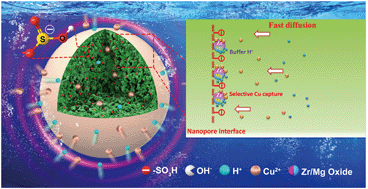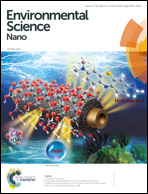Elaborate design of polymeric nanocomposites with Mg(ii)-buffering nanochannels for highly efficient and selective removal of heavy metals from water: case study for Cu(ii)†
Abstract
Nanostructured metal oxide bearing composites are new-generation materials for the removal of various heavy metals from water, however, they are inefficient when used in acidic solutions, because of their poor stability, strong H+ competition and surface charge repulsion. To overcome these problems, we designed a new composite (Zr/Mg oxide-PS), which was synthesized by doping hybrid Mg and Zr oxides into negatively charged sulfonated polystyrene (PS) to extend the applicability of such composites to Cu(II) removal in acidic wastewaters. Three different modes of action are involved: the embedded Mg(II) oxide acts as a buffer against changes in the internal solution environment in the nanopore region; the hybrid nano-Zr(IV) oxide together with the Mg(II) species, provides good Cu sorption; and the –SO3H group that is immobilized on the matrix improves access to Cu(II). The obtained Zr/Mg oxide-PS has extensive applicability to acidic Cu-contaminated waters and gives a selectivity of approximately 20 times greater than that of ZrO2-PS. For the wastewater application, an excellent adsorption capacity of 4650 kg wastewater per kg of sorbent was achieved. The effluent met World Health Organization drinking water standards, exhausted materials were readily regenerated, and it was used repeatedly for several cycles. The results suggest that this Mg-containing composite has potential applications in the remediation of acidic heavy-metal-containing wastewaters.



 Please wait while we load your content...
Please wait while we load your content...